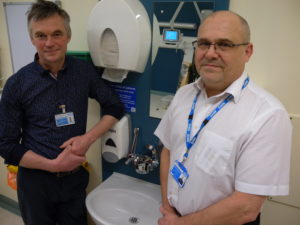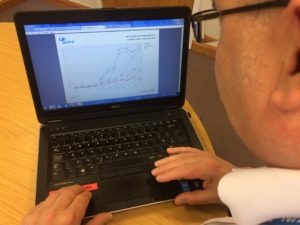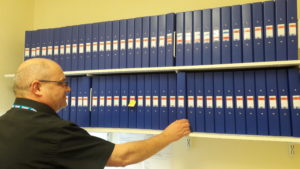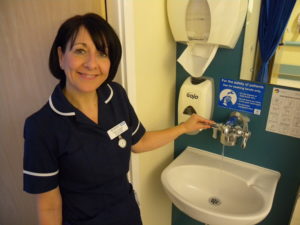“Brilliant system” helps ensure flushing and compliance

The logistical problem of ensuring outlets are flushed and maintaining the associated mountain of records are a thing of the past at Worcestershire Acute Hospitals NHS Trust. L8guard, a web-based system, has solved all the issues and staff find it easy to use.
Recalling the challenges that will be familiar to many estates teams, Simon Noon, the trust’s principal engineer, statutory standards manager, and responsible person for Legionella, tells Hospital Times: “In the beginning, we recorded all the outlets at the trust’s hospitals and put them on a “flushing” sheet. We asked the housekeepers to flush the taps according to the guidance and to sign the sheet to say they had flushed the outlets. There was no guarantee. No way that it could be audited.
“While some of the staff were good, others were not as helpful. They felt that outlet flushing should not be part of their remit. Many of the ‘flushing’ sheets we received were a mess. Some of the folders were lost or the departments used them for other purposes. We had to constantly chase staff over all the issues. The amount of time and resources needed to do this and to keep up with the tons of paperwork was a nightmare.

“The system was stalling through the sheer inertia of trying to get the departments to appreciate the need for the flushing regime. We simply did not have enough staff to do it.”
John Foxall, the trust’s water quality technician, explains: “I created over 400 folders for the paperwork. This covered 200 departments and 200 duplicates, which I held. I had to collect the sheets and speak to staff about all the issues. The time taken was horrendous.”
Noon says: “When we learned about L8guard we could see the benefits straight away. It looked cost-effective. It would free-up time and allow us to get on with more useful work.”
The decision was taken to run a three-month trial on three sites, with one ward at each site.
The trial was a resounding success. “It proved very popular,” says Noon. “We could see the benefits immediately. We did some training forums with matrons, link nurses, infection prevention and control, cleaners and housekeepers. We explained why we were introducing the system and the importance of a good flushing regime for patient safety.
“We loved it as our administration burden went down. It’s simple. L8guard records whether you have flushed or not and, if not, it will escalate the issue to the next person on the chain. It’s all computerised, it tells you everything. You can log-on and look at individual outlets. It’s brilliant, a cracking system. We’ve really benefitted from it.
“We produce reports for the trust infection prevention and control meeting. We can identify who’s flushed and who hasn’t so the chief nurse knows at a glance where we are. She’s delighted with it. They also chase departments where there might be issues.”
Foxall adds: “The trial gave us an accurate record. It was easier for staff and they welcomed it. It was my responsibility to provide L8guard with all the primary and secondary flushing contacts for them to populate the database. The primary contact is the person who undertakes the flushing. The secondary is the escalation contact, who is advised if the flushing is not completed.”
The L8guard system automatically e-mails nominated staff in each department to remind them to perform the flushing action on an agreed schedule. In legionella areas recipients have 24-hours to file a return online by clicking a link embedded within the e-mail. If they do not report to L8guard within this time limit, an escalation will be sent to someone senior reminding them to perform the task required.
Administration can check the status of returns in real-time through the administration interface, which also provides access to manual reports and graphs, as well as the historical reports archive.

L8guard will automatically generate and send out performance reports and graphs identifying areas of success and concern, and highlights ‘repeat offenders’ – enabling any localised problems to be addressed quickly and easily.
The Pseudomonas module expands this function into the daily flushing of pre-identified outlets. It follows a similar process, but all reminders, escalations, and failure warnings are contained within a day.
Following the success of the trial, the use of L8guard was rolled out across Kidderminster Hospital, Alexandra Hospital, and Worcestershire Royal Hospital. It has also been introduced at Princess of Wales Community Hospital, Bromsgrove, and Evesham Community Hospital, where L8guard is used in the areas which the trust occupies.
Noon explains: “Some trusts only flush sentinel taps. We decided to nominate that all taps are monitored. The water consumption spikes when the flushing is being done. We undertake a lot of samples and test more frequently and we’re not finding any issues.
“We have ProEconomy’s Orca silver and copper ionisation system at Alexandra Hospital and at Kidderminster Hospital. We need to pull the biocide through the system to the outlet. As part of the training, we explained to the staff that we needed to do this to help ensure patient safety. We have a chlorine dioxide system at Worcestershire Royal, where the same rationale applies.
“We’ve increased the testing regime, taking a lot more samples than we used to. We try to prove we haven’t got legionella by doing a wide-ranging sampling regime. Everything’s looking good.
“The system has the support of the staff. They seem to be more concerned about the veracity of the information now that it’s electronic, rather than on paper.”
John says; “L8guard used our flushing sheets to set up the database. The system has enabled accurate record keeping. With the paper-based system, we used to find that some areas had been taken out of use that we did not know about. Now, with the electronic system, staff advise when departments change.”
Foxall adds; “I can’t fault it. The system, the software, the alerts, the assistance and back-up, from both Sue Dancer, operations manager, and Tim Moore, Digital Missives director and L8guard’s creator and developer – it’s second to none.”

Offering a clinical perspective, Michelle Chester, unit manager of the Garden Suite, says: “L8guard helps us ensure compliance. The system works very well. We have to complete the information online, so it ensures we do the tap flushing. If you haven’t done it, you get an alert. It confirms for us that the water is at safe levels. It’s good for immunocompromised patients.”
Chester adds “We haven’t had any positive Pseudomonas in 22 months.”
Heather Gentry, lead infection prevention and control nurse, explains: “Staff had problems with the paper-based system. Folders would get lost. There’s the length of time you have to keep the records, which means you need a repository. L8guard has made us paperless.
“In a busy environment, the fact that someone will get an e-mail if the entry has not been made is a real benefit. If the entries are missed, alerts are escalated to me, in my capacity as the lead infection prevention and control nurse. It’s a massive improvement of our compliance because it’s so efficient and so quick.”
Gentry adds: “After five years of trying to improve on compliance with flushing, this system in just a few months has shown a massive improvement. It now offers assurance to the trust management board and others that we have a robust water management system in place. We can produce audits of compliance at the click of a button. John Foxall reports to the Water Safety Group, which in turn reports to the trust infection prevention and control committee. The reports have also been used as evidence of compliance for CQC visits.”
Tim Moore, designer and developer of L8guard, says: “The system puts people in control of the action and reporting system to the benefit of patient care.
“We are in constant contact with our users, regularly updating the system to make it more efficient. Enhancements are shared across all clients. It’s one of the benefits of a web-based system. There’s 128bit encryption and all data is backed-up twice-daily to redundant servers. Being a web-based system, there is no installation, which keeps the IT departments happy.
“Users find it’s a simple and extremely cost-effective solution to a tricky problem.”
Noon adds: “We’re happy to be a reference site and talk to anyone who is interested in the system. We’d certainly recommend it. Using L8guard has been a very positive experience for us.”
For further information, call L8guard on 0113 815 0383, e-mail enquiries@l8guard.co.uk or visit www.l8guard.co.uk
